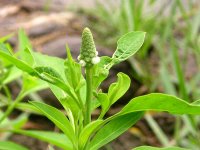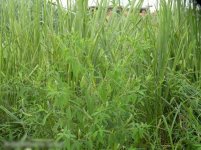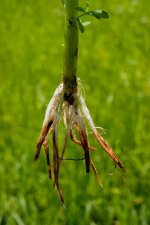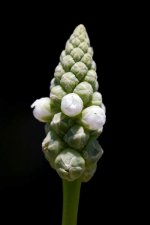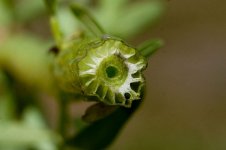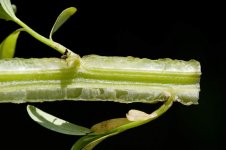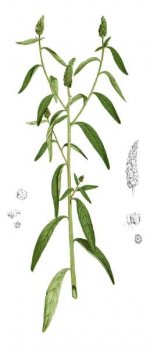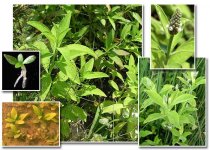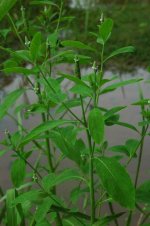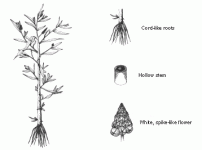You are using an out of date browser. It may not display this or other websites correctly.
You should upgrade or use an alternative browser.
You should upgrade or use an alternative browser.
مسابقه علمی *** کی این علف هرز را می شناسه ؟
- شروع کننده موضوع **آگاهدخت**
- تاریخ شروع
آفرین زیبا خانم خودشه عالی بود، سوال بعد را بفرمائید...یافتیم !
Diplotaxis tenuifolia !
It grows in clumps on the ground in a variety of habitats and is a common weed of roadsides and disturbed areas.
The branches are often used as an ingredient for salads !!! .
In the Germanic realm this herb has been known since the ancient world.[citation needed] It had slightly fallen out of favour but came back into fashion recently as a result of Italian cuisine's popularity.
(Lincoln weed (Diplotaxis tenuifolia
Lincoln weed, (Diplotaxis tenuifolia) also known as sand rocket and sand mustard, is a weed of the turnip family (Brassicaceae) which includes many other Western Australian weeds such as wild turnip, wild mustard, and wild radish. An isolated patch of Lincoln weed has been found in Western Australia.
It is a weed of mainly waste land and poorer pastures in the Eyre Peninsular of South Australia and Victoria where it was introduced from Europe, probably as a seed contaminant. It prefers well drained sandy soils often with high calcium content.
It is an almost hairless perennial, forming a dense bushy rosette with erect branched stems usually 20 to 50 cm high. It displays small bright yellow flowers on short flowering stems from October to February. Each has only four petals, spread out in the shape of a Maltese cross. The leaves are lance shaped, up to 15 cm long with irregular lobes. They are mainly confined to the lower parts of the stems and rosette. The fruit is a pod from one to four cm long by five mm diameter with a small beak-shaped end, the seeds are arranged in two rows. The part nearest the stem opens first, shedding seed. Lincoln weed forms a long tap root which utilises water from deep underground. This enables it to survive and grow throughout summer.
Seeds germinate in autumn and make slow growth through winter. In the spring they grow more rapidly, flowering in October. In autumn the top growth dies back until next spring.
Lincoln weed is said to be poisonous but stock generally ignore it except at flowering, due to its marked "foxy" odour. If eaten as hay, it will taint milk and meat.
It strongly competes with crops and useful pasture plants and the wiry stems make hay cutting difficult. It is difficult to kill with most herbicides.
Lincoln weed is spread mainly by seeds, although cultivation may break off root fragments, which if large enough, can regenerate to produce new plants.
It is essential that Lincoln weed is not allowed to become established in Western Australia.
Lincoln weed, (Diplotaxis tenuifolia) also known as sand rocket and sand mustard, is a weed of the turnip family (Brassicaceae) which includes many other Western Australian weeds such as wild turnip, wild mustard, and wild radish. An isolated patch of Lincoln weed has been found in Western Australia.
It is a weed of mainly waste land and poorer pastures in the Eyre Peninsular of South Australia and Victoria where it was introduced from Europe, probably as a seed contaminant. It prefers well drained sandy soils often with high calcium content.
It is an almost hairless perennial, forming a dense bushy rosette with erect branched stems usually 20 to 50 cm high. It displays small bright yellow flowers on short flowering stems from October to February. Each has only four petals, spread out in the shape of a Maltese cross. The leaves are lance shaped, up to 15 cm long with irregular lobes. They are mainly confined to the lower parts of the stems and rosette. The fruit is a pod from one to four cm long by five mm diameter with a small beak-shaped end, the seeds are arranged in two rows. The part nearest the stem opens first, shedding seed. Lincoln weed forms a long tap root which utilises water from deep underground. This enables it to survive and grow throughout summer.
Seeds germinate in autumn and make slow growth through winter. In the spring they grow more rapidly, flowering in October. In autumn the top growth dies back until next spring.
Lincoln weed is said to be poisonous but stock generally ignore it except at flowering, due to its marked "foxy" odour. If eaten as hay, it will taint milk and meat.
It strongly competes with crops and useful pasture plants and the wiry stems make hay cutting difficult. It is difficult to kill with most herbicides.
Lincoln weed is spread mainly by seeds, although cultivation may break off root fragments, which if large enough, can regenerate to produce new plants.
It is essential that Lincoln weed is not allowed to become established in Western Australia.
قندرونک نیست ؟ آخه برگاش و یکمی گلاش شبیه قندرونک
قندرونک نیست ؟ آخه برگاش و یکمی گلاش شبیه قندرونک
اینی که گفتی چی بید ؟ اسم علمیشو بگو
اینی که گفتی چی بید ؟ اسم علمیشو بگو
ای وویی ببخشید هواسم نبود مال علف هرز مزارع گندم و جو هست اسم علمیش:Chondrilla jouncea
از خانواده Asteraceae
ای وویی ببخشید هواسم نبود مال علف هرز مزارع گندم و جو هست اسم علمیش:Chondrillajouncea
از خانواده Asteraceae
نوچ اشتباهس باجی !
این دوستمون با نام کاربری عددی کجاست جواب بده؟ اگه نمیگید تا من بگم...
این دوستمون با نام کاربری عددی کجاست جواب بده؟ اگه نمیگید تا من بگم...
سلام به همگي
استاد بابت سوال سختتون كه باعث شد همه جا رو زيرو رو كنيم سپاس
وآفرين به دوست گرامي زيبا خانم براي تلاش جدي كه داشتن

من تازه از دانشگاه برگشتم اصلا حضور ذهن ندارم

زحمت بكشيد خودتون....
ما استفاده ميكنيم
ممنون دوست عزیز، شما لطف دارید. زیبا خانم متخصص جواب دادن به سوالات سخت هستند...سلام به همگي
استاد بابت سوال سختتون كه باعث شد همه جا رو زيرو رو كنيم سپاس
وآفرين به دوست گرامي زيبا خانم براي تلاش جدي كه داشتن
من تازه از دانشگاه برگشتم اصلا حضور ذهن ندارم
زحمت بكشيد خودتون....
ما استفاده ميكنيم
علف غاز یا ورث آبزی (Sphenoclea zeylanica) از تیره Sphenocleaceae.
توضیحات:
علف غاز یا ورث آبزی گیاهی است یکساله ایستاده، آبزی، ساقه صاف، ضخیم، توخالی و منشعب به ارتفاع 30 تا 150 سانتی متر. گل آذین سنبله انتهایی، سبز، استوانه ای و فشرده. بذور به تعداد زیاد و به رنگ زرد-قهوه ای به طول نیم میلی متر. تکثیر با بذر. این گیاه بیشتر در قسمت تنک مزرعه برنج رویش پیدا میکند و ضمن رقابت در امر برداشت نیز مزاحمت ایجاد میکند. این علف هرز به خصوص در مناطق گرم مانند خوزستان، سیستان و بلوچستان و فارس بیشتر گسترش بافته و در اکثر موارد از تراکم بالایی نیز برخوردار بوده و بیشتر طالب آبهای راکد است.
علف غاز یا ورث آبزی گیاهی است یکساله ایستاده، آبزی، ساقه صاف، ضخیم، توخالی و منشعب به ارتفاع 30 تا 150 سانتی متر. گل آذین سنبله انتهایی، سبز، استوانه ای و فشرده. بذور به تعداد زیاد و به رنگ زرد-قهوه ای به طول نیم میلی متر. تکثیر با بذر. این گیاه بیشتر در قسمت تنک مزرعه برنج رویش پیدا میکند و ضمن رقابت در امر برداشت نیز مزاحمت ایجاد میکند. این علف هرز به خصوص در مناطق گرم مانند خوزستان، سیستان و بلوچستان و فارس بیشتر گسترش بافته و در اکثر موارد از تراکم بالایی نیز برخوردار بوده و بیشتر طالب آبهای راکد است.
ممنون دوست عزیز، شما لطف دارید. زیبا خانم متخصص جواب دادن به سوالات سخت هستند...
ای وای خجالتم ندیدن
 من اینجا شاگرد همه مهندسان بزرگوار هستم
من اینجا شاگرد همه مهندسان بزرگوار هستم مهندس بفرمائین سؤال بعدی رو
ممنون، بفرمائید سوال بعد...


آخرین ویرایش:
سلام من تا اينجا اين جدول رو يافتم
بايد بگردم دنبال توضيحات
به نظر چيني مياد
بايد بگردم دنبال توضيحات
به نظر چيني مياد

Classification
Kingdom- Plantae
Subkingdom- Tracheobionta
Superdivision- Spermatophyta
Division- Magnoliophyta
Class- Magnoliopsida
Subclass- Caryophyllidae
Order- Caryophyllales
Family- Caryophyllaceae
Genus- Lepyrodiclis
Species- Lepyrodiclis holosteoides
اسم درستش همون ارشته خطائی است، علف هرز مهم مزارع گندم از خانواده میخک...یه جا نوشته بود علف آش، یه جای دیگه جو گندومک، یه جای دیگه هم ارشته خطائی!
بله درسته نام علمی درسته آفرین...سلام من تا اينجا اين جدول رو يافتم
بايد بگردم دنبال توضيحات
به نظر چيني مياد ClassificationKingdom- PlantaeSubkingdom- TracheobiontaSuperdivision- SpermatophytaDivision- MagnoliophytaClass- MagnoliopsidaSubclass- CaryophyllidaeOrder- CaryophyllalesFamily- CaryophyllaceaeGenus- LepyrodiclisSpecies- Lepyrodiclis holosteoides
ClassificationKingdom- PlantaeSubkingdom- TracheobiontaSuperdivision- SpermatophytaDivision- MagnoliophytaClass- MagnoliopsidaSubclass- CaryophyllidaeOrder- CaryophyllalesFamily- CaryophyllaceaeGenus- LepyrodiclisSpecies- Lepyrodiclis holosteoides
Lepyrodiclis
Lepyrodiclis holosteoides
Weed Class:B
Year Listed:1988
Native to:Europe, Asia
Toxic:not known to be
Why is it a noxious weed?
Lepyrodiclis infests grain and pea fields where it grows up and over crops forming a canopy that shades crops from the sun.
How would I identify it?
General Description:Lepyrodiclis is a fast growing annual with a prostrate habit except when given something to climb upon. It flowers in the spring.
Flower Description:Flowers are axillary and terminal on stems. Flowers have 5 green sepals and 5 petals that are white or pink.
Leaf Description:Leaves are oppositely arranged and lance shaped or narrowly oval with one main mid vein. Leaf size generally varies from 0.4 to 3.1 inches long by 0.1 to 0.4 inches wide.
Stem Description:Stem are slender, week, sprawling or upright, and 16 to 40 inches long. Stems are clustered at the base of the plant and weakly attached to the roots.
Fruit/Seed Description:Small capsules, 0.1 inch long, contain 1 to 2 (sometimes 4) dark brown seeds.
May be confused with:
How does it reproduce?
Lepyrodicilis reproduces by seed.
Where does it grow?
It occurs in disturbed areas, grain fields and pea fields. Pleaseclick hereto see a county level distribution map of lepyrodiclis in Washington.
How do I control it?
General Control Strategy
Treatment should extend at least 20 feet beyond the boundary of observed plants to lessen the chance that additional plants establish from stray seed.
Mechanical Control
Small patches may be pulled and bagged. Tillage can be used to kill lepyrodiclis for patches too large for hand removal.
Cultural Control
Grass competition may help suppress it.
Herbicide Control
مشاهده پیوست 104954
ارشته خطایی (Lepyrodiclis holosteoides) از تیره میخک (Caryophyllaceae):
یکساله با رویش بهاره، علفی با گلهای سفید فراوان. ارتفاع تا 60 سانتی متر. ساقه نازک با انشعابات متعدد که منظره گسترده و بوته ای به گیاه می دهد. برگها بزرگ، نیزه ای، بدون دمبرگ. برگها و ساقه بدون مو. برگهای بذری (کوتیلیدونی) مستطیلی و بدون دمبرگ. به عنوان علف هرز مزارع گندم شناخته می شود. این علف هرز از نقاط مختلف ایران گزارش شده ولی شدیدترین آلودگی مربوط به استان آذربایجان غربی می باشد. به طوری که در برخی مزارع گندم شدت آلودگی به حدی است که برای تولید گندم اشکال جدی بوجود می آید. گونه های کم اهمیت تر آن در سایر نقاط ایران عبارتند از: L. cerastioides، L. strllaroides و L. paniculata.

یکساله با رویش بهاره، علفی با گلهای سفید فراوان. ارتفاع تا 60 سانتی متر. ساقه نازک با انشعابات متعدد که منظره گسترده و بوته ای به گیاه می دهد. برگها بزرگ، نیزه ای، بدون دمبرگ. برگها و ساقه بدون مو. برگهای بذری (کوتیلیدونی) مستطیلی و بدون دمبرگ. به عنوان علف هرز مزارع گندم شناخته می شود. این علف هرز از نقاط مختلف ایران گزارش شده ولی شدیدترین آلودگی مربوط به استان آذربایجان غربی می باشد. به طوری که در برخی مزارع گندم شدت آلودگی به حدی است که برای تولید گندم اشکال جدی بوجود می آید. گونه های کم اهمیت تر آن در سایر نقاط ایران عبارتند از: L. cerastioides، L. strllaroides و L. paniculata.

سلام
ميلاد مهدي(عج) ،تصنيف سرخ ترانه هاي انتظار بر همگان مبارك .
با تشكر از استاد واجازه تمامي دوستان سوال بعدي:
مشاهده پیوست 104976مشاهده پیوست 104977
ميلاد مهدي(عج) ،تصنيف سرخ ترانه هاي انتظار بر همگان مبارك .
با تشكر از استاد واجازه تمامي دوستان سوال بعدي:
مشاهده پیوست 104976مشاهده پیوست 104977


